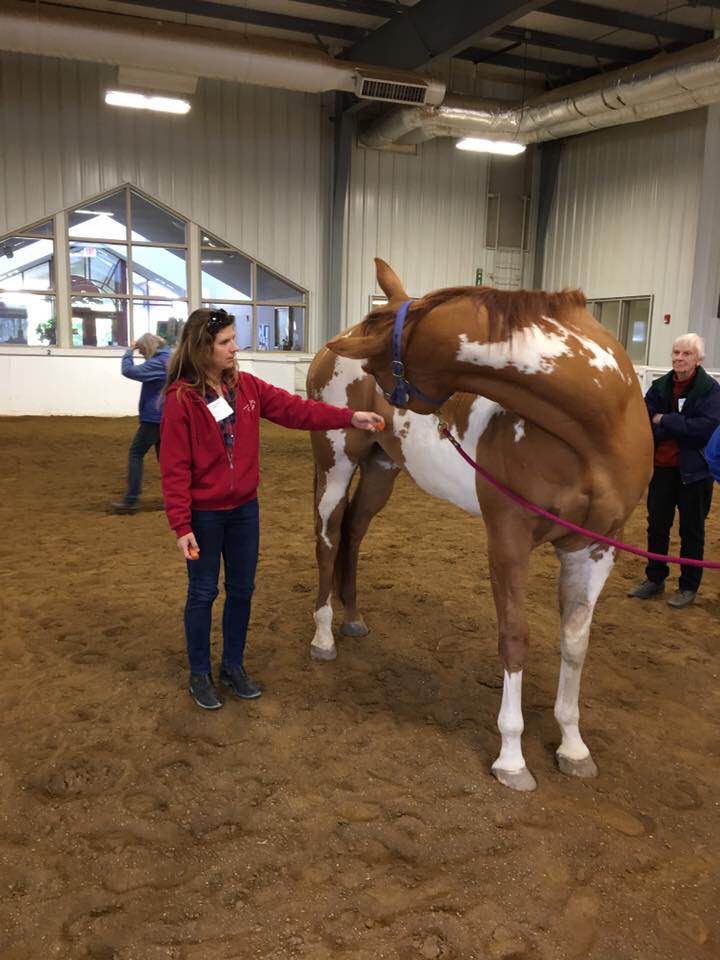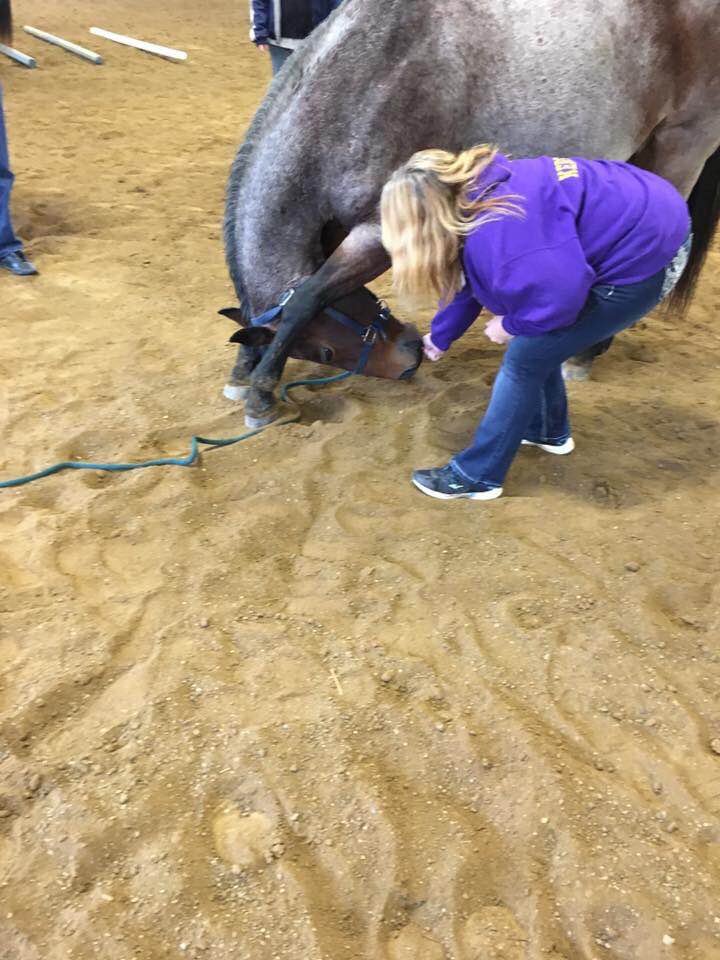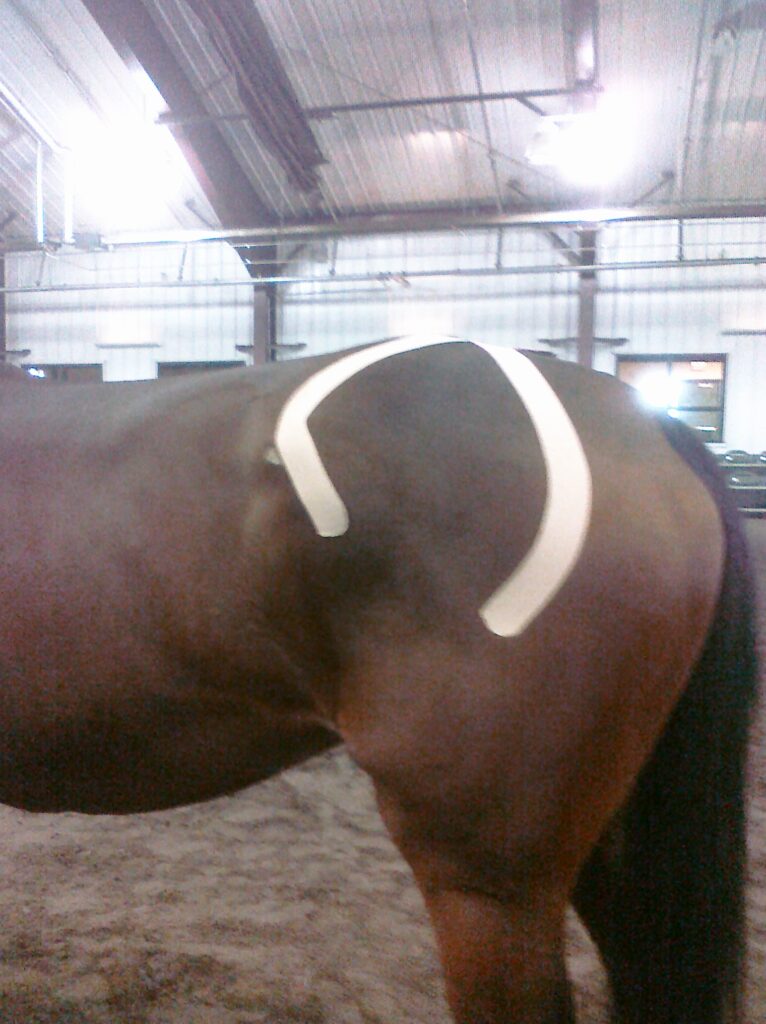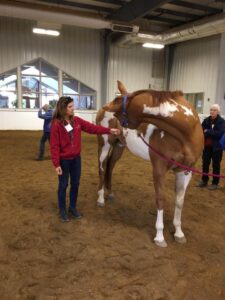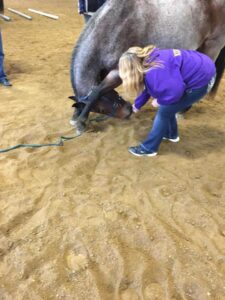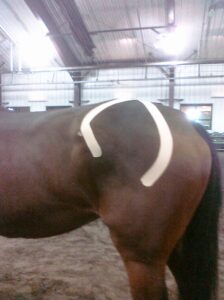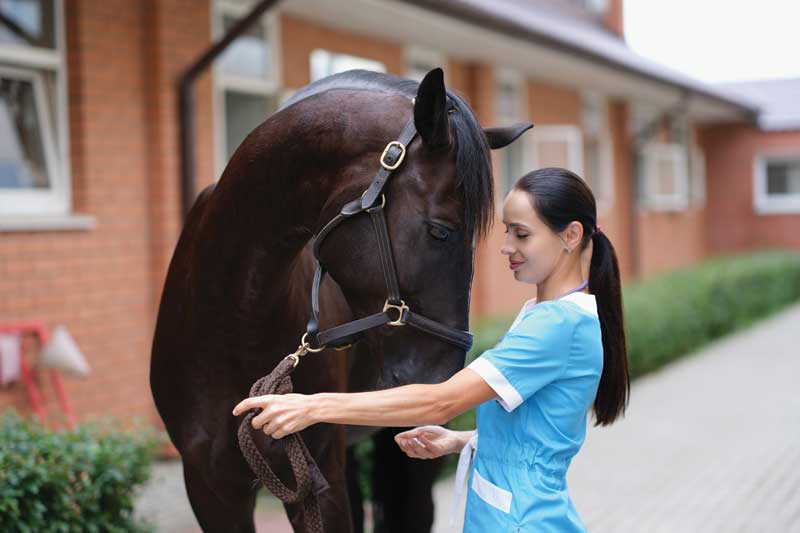 Equine prehabilitation (prehab) and rehabilitation (rehab) strategies that maintain and improve horse health and recovery can be easy to incorporate into your clinical practice. Rehabilitation techniques to support musculoskeletal health and quicken return to function post injury have become integral parts of equine practice and a focus of interest for horse owners.
Equine prehabilitation (prehab) and rehabilitation (rehab) strategies that maintain and improve horse health and recovery can be easy to incorporate into your clinical practice. Rehabilitation techniques to support musculoskeletal health and quicken return to function post injury have become integral parts of equine practice and a focus of interest for horse owners.
These techniques complement general strengthening and controlled exercise plans, can be performed on the farm, and range from core strengthening, baited stretches, pole work, surface work, ice, heat, physiotaping, double lunging, and jangles.
Below are guidelines to help practitioners identify current prehab and rehab techniques that can be performed on the farm, to apply appropriate prehab and rehab strategies for various clinical scenarios, and to identify which strategies have scientific backing of their efficacy.
Core strengthening exercises
Topline and abdominal muscles are important for sustained musculoskeletal health. Core muscle groups that are important for postural stabilization of the horse include: multifidus, longissimus, biceps femoris, gluteals, quadriceps, and the abdominal musculature.1,2
- Baited stretches can be performed as a horse is encouraged to reach for a desired treat.2-5 This can improve the range of motion laterally and will activate different muscle groups depending on whether the lateral bend is directed towards the hip, stifle, or barrel while bending around the owner.
Ventral or rounding stretches can be directed to the level of the chest, fetlocks, or between the front legs. Both the lateral bending and ventral rounding exercises are increased in difficulty if the horse accomplishes them while resting or elevating one leg off of the ground.
- Non-baited stretches. For horses not food-motivated or for those that treats might put them at risk for laminitis, examples of non-baited exercises to improve the topline musculature +/- the abdominal muscles include: sternal lift (fingers tickle under the sternum), tail tuck (fingers or a hoof pick tickles by the tailhead), a combination of the two, and rocking back (accomplished by lifting one front leg and rocking the horse back onto its haunches by pushing on the shoulder). A lateral tail pull is a great exercise targeting the quadriceps, which is great for stabilizing stifles in instances where there is intermittent locking of the patella.
Horses should perform the exercises after they have been ridden and repeat the exercise at least three times, or ideally, five times a week. When horses first start, they may only be able to hold the position for a few seconds. Gradually work up to a 20- to 30-second hold.
For any of the above exercises, evasions can include twisting the neck, moving sideways, backing up, dropping a held leg. Placing the horse against a wall or corner can help prevent some evasions.
Proprioception and/or strengthening
To aid with proprioception, devices like tactile stimulators can be intermittently used to increase the flight arc of leg. The horse does habituate to this device over time,6,7 but it can be useful in the short term or if there is asymmetry between heights attained with each leg. It is important to note this device does not work by adding weight to the leg, but through the tactile stimulation of the coronary band.
- Physiotape or kinesiotape has mixed results for improvement of muscular control in the human literature; however, in horses it continues to be used for various musculoskeletal injuries (sacroiliac pain, intermittently locking patellas, hock pain), weakness, and neurologic issues. 8,9,10 In the horse, its use on the brachiocepalicus and extensor carpi radialis muscles of the forearm did not result in any joint movement changes.11 Kinesio taping also did not improve back flexion and extension overall at the trot, though some individual horses showed positive responses.12
- Resistance bands aim to improve back and abdominal musculature (improves core and strengthens the circle of muscles) via tension place around the abdomen or semimembranosus and semitendinosus muscles.13 Use while ridden or with a double lunge and/or side reins to ensure that the horse’s back does not hollow are critical to building the topline.
Use of the resistance bands in a four-week exercise regimen showed some support for increasing muscular stability.13,14 Horses with insulin dysregulation and/or pituitary pars intermedia dysfunction (PPID or Cushing’s) may benefit from these resistance exercises. Double lunging is also useful for horses that cannot take the extra burden of the rider’s weight but still need to be started back in work.
- Cavaletti/poles. Electromyography has shown cavaletti poles activate various muscles during stance and swing phase in dogs.15 In the stance phase in horses trotting over poles, there is a suggestion that the forelimb adductors are activated.16 Increasing the height of the trot poles increased joint flexion via flexor muscle activation to increase hoof height.17
Having poles placed unevenly or up or down a hill also encourages coordination that can be helpful in addressing some neurologic cases.17 At the walk, poles can increase joint range of motion during the swing phase of the stride.18
- Surfaces. Changes in exercise surfaces19 play important roles in human rehabilitation, as different firmness surfaces affect joint angles in horses as well as humans. While different surfaces have not been investigated extensively in horses, some preliminary work with soft, somewhat unstable cushions has been performed. The type of injury should also be considered, with rehabilitation of a soft tissue injury ideally occurring on a firmer surface, while rehabilitation of a bone/joint injury should occur on a softer one.
- Treadmills. Land and water treadmills20,21 have had unique roles in rehabilitation of horses from injury and for muscle strengthening. In a carpal chip model, walking in the water treadmill resulted in clinical improvements in the limb, greater positional stability, and decreases in joint inflammation.22,23
Water height is important to consider for maximizing the flexion and extension of the joint of interest.21 Water height (stifle level) and treadmill speed also influences how hard horses have to work in the treadmill.24 Back movement is also facilitated with the water treadmill.25
- Ice, heat and pressure have all been parts of athletic approaches to joint and muscular health.26 Some systems incorporate both cooling and pressure, while a pre-wet ice sleeve works predominantly as a cooling device. Regular wraps and products that claim to increase blood flow to the area via ceramic particles have also been part of a pre and post competitive regime.
In summary, rehabilitation techniques support equine musculoskeletal health and quicken return to function post injury. Rehab techniques can be employed by veterinarians, technicians, or owners. Core exercises, like baited stretching, are easy to do and can be modified for horses that are not food-motivated or those that have endocrine disease.
Proprioception and strengthening exercises can go hand in hand. Devices such as resistance bands, tactile stimulators, and physio tape have a place in practice settings.
Jane Manfredi, DVM, MS, PhD, DACVS-LA, DACVSMR (Equine), is an assistant professor in the Department of Pathobiology and Diagnostic Investigation at Michigan State University’s College of Veterinary Medicine. Dr. Manfredi graduated from the Atlantic Veterinary College (Prince Edward Island, Canada), and spent time in a private mixed large animal private practice and at two Chicago racetracks before completing a large animal surgical residency at the University of Minnesota. Manfredi completed a PhD at Michigan State in Comparative Medicine and Integrative Biology and became boarded in equine sports medicine and rehabilitation before joining the faculty. Her research interests include osteoarthritis, rehabilitating the performance horse, and metabolic syndrome.
References
- Rombach N, Stubbs NC, Clayton HM. Gross anatomy of the deep perivertebral musculature in horses. Am J Vet Res 2014;75:433-440. https://pubmed.ncbi.nlm.nih.gov/24762014/
- Stubbs NC, Kaiser LJ, Hauptman J, et al. Dynamic mobilisation exercises increase cross sectional area of musculus multifidus. Equine Vet J 2011;43:522-529. https://pubmed.ncbi.nlm.nih.gov/21496085/
- Clayton HM. Core Training and Rehabilitation in Horses. Vet Clin North Am Equine Pract 2016;32:49-71. https://pubmed.ncbi.nlm.nih.gov/27012507/
- Clayton HM, Kaiser LJ, Lavagnino M, et al. Evaluation of intersegmental vertebral motion during performance of dynamic mobilization exercises in cervical lateral bending in horses. Am J Vet Res 2012;73:1153-1159. https://pubmed.ncbi.nlm.nih.gov/22849675/
- Clayton HM, Kaiser LJ, Lavagnino M, et al. Dynamic mobilisations in cervical flexion: Effects on intervertebral angulations. Equine Vet J Suppl 2010:688-694. https://pubmed.ncbi.nlm.nih.gov/21059082/
- Clayton HM, White AD, Kaiser LJ, et al. Hindlimb response to tactile stimulation of the pastern and coronet. Equine Vet J 2010;42:227-233. https://beva.onlinelibrary.wiley.com/doi/abs/10.2746/042516409X478505#:~:text=More%20specifically%2C%20tactile%20stimulation%20of,action%20of%20the%20stifle%20musculature
- Clayton HM, White AD, Kaiser LJ, et al. Short-term habituation of equine limb kinematics to tactile stimulation of the coronet. Vet Comp Orthop Traumatol 2008;21:211-214. https://pubmed.ncbi.nlm.nih.gov/18536846/
- Lins CA, Borges DT, Macedo LB, et al. Delayed effect of Kinesio Taping on neuromuscular performance, balance, and lower limb function in healthy individuals: a randomized controlled trial. Braz J Phys Ther 2016;20:231-239. https://www.ncbi.nlm.nih.gov/pmc/articles/PMC4946839/
- Dilek B, Batmaz I, Sariyildiz MA, et al. Kinesio taping in patients with lateral epicondylitis. J Back Musculoskelet Rehabil 2016. https://pubmed.ncbi.nlm.nih.gov/27232082/
- Molle S. Kinesio Taping Fundamentals for the Equine Athlete. Vet Clin North Am Equine Pract 2016;32:103-113. https://pubmed.ncbi.nlm.nih.gov/26898963/
- Zellner A, Bockstahler B, Peham C. The effects of Kinesio Taping on the trajectory of the forelimb and the muscle activity of the Musculus brachiocephalicus and the Musculus extensor carpi radialis in horses. PLoS One 2017;12:e0186371. https://journals.plos.org/plosone/article?id=10.1371/journal.pone.0186371#:~:text=Conclusion-,To%20sum%20up%2C%20Kinesio%20Taping%20on%20the%20M.,muscle%20activity%20of%20the%20M
- Ericson C, Stenfeldt P, Hardeman A, et al. The Effect of Kinesiotape on Flexion-Extension of the Thoracolumbar Back in Horses at Trot. Animals (Basel) 2020;10. https://pubmed.ncbi.nlm.nih.gov/32069962/
- Simons V, Weller R, Stubbs NC, et al. Clinical Research Abstracts of the British Equine Veterinary Association Congress 2015. Equine Vet J 2015;47 Suppl 48:11. https://pubmed.ncbi.nlm.nih.gov/26375173/
- Pfau T, Simons V, Rombach N, et al. Effect of a 4-week elastic resistance band training regimen on back kinematics in horses trotting in-hand and on the lunge. Equine Vet J 2017;49:829-835. https://pubmed.ncbi.nlm.nih.gov/28432739/
- Breitfuss K, Franz M, Peham C, et al. Surface Electromyography of the Vastus Lateralis, Biceps Femoris, and Gluteus Medius Muscle in Sound Dogs During Walking and Specific Physiotherapeutic Exercises. Vet Surg 2015;44:588-595. https://pubmed.ncbi.nlm.nih.gov/25328985/
- Clayton HM, Stubbs NC, Lavagnino M. Stance phase kinematics and kinetics of horses trotting over poles. Equine Vet J 2015;47:113-118. https://pubmed.ncbi.nlm.nih.gov/24580416/
- Brown S, Stubbs NC, Kaiser LJ, et al. Swing phase kinematics of horses trotting over poles. Equine Vet J 2015;47:107-112. https://pubmed.ncbi.nlm.nih.gov/24593249/
- Walker VA, Tranquillle CA, MacKechnie-Guire R, et al. Effect of Ground and Raised Poles on Kinematics of the Walk. J Equine Vet Sci 2022;115:104005. https://www.sciencedirect.com/science/article/abs/pii/S0737080622001435#:~:text=Walking%20over%20poles%20increases%20fore,range%20of%20motion%20(ROM).&text=Walking%20over%20ground%20and%20raised,and%20hindlimb%20swing%20phase%20flexion
- Mendez-Angulo JL, Firshman AM, Groschen DM, et al. Impact of walking surface on the range of motion of equine distal limb joints for rehabilitation purposes. Vet J 2014;199:413-418. https://pubmed.ncbi.nlm.nih.gov/24556081
- Firshman AM, Borgia LA, Valberg SJ. Effects of training at a walk on conventional and underwater treadmills on fiber properties and metabolic responses of superficial digital flexor and gluteal muscles to high-speed exercise in horses. Am J Vet Res 2015;76:1058-1065. https://pubmed.ncbi.nlm.nih.gov/26618730/
- Mendez-Angulo JL, Firshman AM, Groschen DM, et al. Effect of water depth on amount of flexion and extension of joints of the distal aspects of the limbs in healthy horses walking on an underwater treadmill. Am J Vet Res 2013;74:557-566. https://www.researchgate.net/publication/236082688_Effect_of_water_depth_on_amount_of_flexion_and_extension_of_joints_of_the_distal_aspects_of_the_limbs_in_healthy_horses_walking_on_an_underwater_treadmill
- King MR, Haussler KK, Kawcak CE, et al. Biomechanical and histologic evaluation of the effects of underwater treadmill exercise on horses with experimentally induced osteoarthritis of the middle carpal joint. Am J Vet Res 2017;78:558-569. https://pubmed.ncbi.nlm.nih.gov/28441054/
- King MR, Haussler KK, Kawcak CE, et al. Effect of underwater treadmill exercise on postural sway in horses with experimentally induced carpal joint osteoarthritis. Am J Vet Res 2013;74:971-982. https://pubmed.ncbi.nlm.nih.gov/23802668/
- Greco-Otto P, Bond S, Sides R, et al. Workload of horses on a water treadmill: effect of speed and water height on oxygen consumption and cardiorespiratory parameters. BMC Vet Res 2017;13:360. https://bmcvetres.biomedcentral.com/articles/10.1186/s12917-017-1290-2
- Mooij MJ, Jans W, den Heijer GJ, et al. Biomechanical responses of the back of riding horses to water treadmill exercise. Vet J 2013;198 Suppl 1:e120-123. https://pubmed.ncbi.nlm.nih.gov/24360735/
- Porter M. Equine rehabilitation therapy for joint disease. Vet Clin North Am Equine Pract 2005;21:599-607, vi. https://pubmed.ncbi.nlm.nih.gov/16297723/

